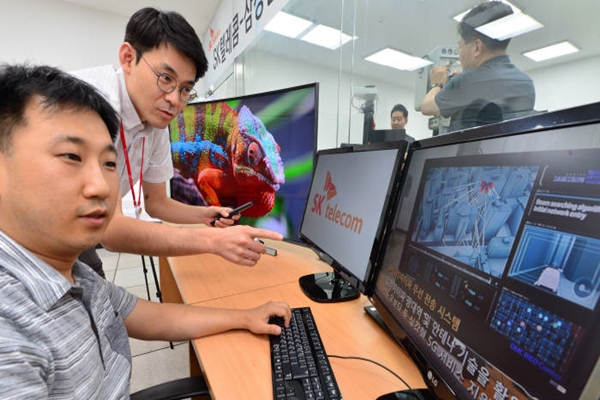During demonstrative service of 5G mobile telecommunication at 2018 Pyeongchang Winter Olympics, more than 10Gbps of service will be implemented through mobile devices through 8-Band CA (Carrier Aggregation) that combines 8 frequencies with 100MHz bandwidths. This speed is 33 times faster than current LTE’s fastest speed at 300Mbps. It is predicted that tangible contents service, which will use 360° tangible images of stadiums, VR, and AR (Augmented Reality) will be possible during this Olympics. Also people will be able to experience a multi-view streaming service called Omniview and remote-controlled drone racing.
Beside of 28GHz bandwidth, which was already introduced before, 8CA with 800MHz bandwidth, MIMO (Multiple-Input Multiple-Output), and Hybrid Beamforming were included in high-rank regulations of 5G demonstrative service that was discussed during ‘4th 5G Strategy Committee’ that was held recently. Dynamic TDD (Time Division Duplex) and subcarrier spacing 75KHz regulations will also be used in this service.
CA, which is being used in 4G LTE also, is a technology that increases speed by combining many frequency bandwidths. Currently a regulation where a maximum speed of 750Mbps is made within 100MHz bandwidth that is made by combining 5 20MHz bandwidths is standardized. Regulation for demonstrative service of 5G combines 8 100MHz bandwidths.
Based on LTE standard (75Mbps per 10MHz bandwidth), maximum theoretical speed is 6Gbps. It is hard to secure such bandwidth at a low frequency and this is why high frequency like 28GHz, which has short distance for radio signal to travel and low diffraction rate, is used.
MIMO uses 8 receiving and 8 transmitting antennas (8x8). Compared to current 2x2 method that uses 2 antennas, MIMO can transfer 4 times more of data. In other words, this indicates that MIMO can make maximum speed of 24Gbps (6x4) since speed is 4 times faster. This kind of speed easily surpasses 20Gbps, which is the standard for 5G that was established by ITU (International Telecommunication Union).
However to implement 8x8 MIMO, base stations and software are needed to support 8x8 MIMO. As of right now, it is an impossible technology from hardware and software perspective and there aren’t any devices that can support such technology. Although there is a system with 8 antennas, it does not use all antennas. To have a successful demonstrative service, this kind of technology needs to be developed by next year.

Subcarrier spacing is 75kHz, which can be seen as a distance between radio signals that carry data and is 5 times faster than LTE (15kHz). Dynamic TDD modifies upper and lower traffic more flexible depending on situations. Because current TDD has fixed transmission ratio of upper and lower traffic, it has lower flexibility and there can be interference phenomena. Beamforming is a technology that modifies amount of radio signals depending on demands and it will be used as a hybrid method between digital and analog for demonstrative service of 5G.
South Korea’s mobile telecommunication businesses and global businesses that are participating in preparation for demonstrative service of 5G will complete detailed regulations during sometime this month. They will develop devices by third quarter of next year and finish establishment of test network by fourth quarter. This test network will be established at Incheon International Airport, Gwanghwamun Gate, and major regions where Pyeongchang Winter Olympics is taking place.
“We are going to carry out same preliminary demonstrative service that was also carried out at the end of last year until February of next year, which is one year before the opening of Olympics.” said Director (Vice-President) Oh Seong-mok of KT’s Network Sector. “Although we have to consider many schedules regarding development of devices, chips and others, we are going to be prepared so that there aren’t any obstacles in our ways.”
3 mobile telecommunication businesses have presented demonstrative services that will be carried out in Pyeongchang and Seoul regions. KT is currently preparing for real-time streaming of player’s point of view, 3D map of stadiums, and multi-view streaming such as Omniview service. People can experience live VR holograms in 5G buses.
SK Telecom is going to introduce 360° image-based tangible media and tangible contents and services that utilizes VR and AR. LG Uplus is going to introduce drone racing that is controlled by remotes, super-multi-view contents play, and test network cluster infrastructure with 20Gbps or higher.
Staff Reporter An, Hochun | hcan@etnews.com